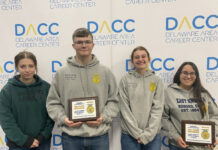Six weeks ago, we brought home six Finnsheep ewes, a milking breed from — you guessed it — Finland. Earlier in the summer, I’d been traveling through Wisconsin and met my first “family milk sheep.” I was enamored by the idea, so when a dairy a few hours south of us put up an ad about downsizing, and one of the ewes was scheduled to lamb in mid-September, I was thrilled. Sheep milk is by far the most delicious milk I’ve ever tasted, and having a fresh supply through the winter would be a tasty and nutritious addition to our diets.
Millie had her baby yesterday — a darling, chocolate-brown ewe lamb with a giant, fluffy crown of white wool on the top of her head. Finnsheep almost always have two or three or even four lambs at once. In fact, that’s why they are able to be used as milking sheep. They need to produce considerably more milk than other breeds in order to feed all those babies. Millie having a single felt like a blessing. More milk for us!
Something didn’t seem quite right though. Millie clearly loved her baby, and her baby clearly loved her, but despite the baby trying multiple times to nurse, it was pretty obvious from the lamb’s concave belly she wasn’t getting any milk.
When I’d first found Millie and the baby out in the little pasture, I’d been totally surprised. There are many benefits to letting a ewe lamb in the pasture. Just like humans, most sheep prefer privacy and freedom to move around while they labor. There’s also a much lower risk of infection to the newborn when their first vulnerable hours are spent on fresh grass instead of straw in a dusty barn. The downside comes if there are complications. It’s harder for the shepherd to intervene.
Because she was a first-time mom and I wanted to keep a close eye on her, I’d planned to move Millie to the corral beside the barn when she was closer to going into labor. Her due date was still a few days away and Millie hadn’t started to “bag up,” a term we use when a sheep or cow’s udders start to fill, usually a sure sign a baby will be arriving soon. Now, Millie’s early labor had thwarted my plans, and I was in a tricky situation because I was pretty sure Millie’s baby wasn’t getting enough milk, but Millie, normally a very friendly, easy-going ewe, was not excited about me messing with her or her baby. New motherhood can be stressful, and that certainly seemed to be how it was feeling to Millie. I had a choice: Leave them be and hope for the best, or steal Millie’s baby to lure her across the yard to the barn, thus causing a whole bunch more anxiety for this already anxious new mom.
I chose intervention, and thank goodness. Once in the barn, Millie calmed down considerably, and even let me try to milk her. Sure enough, she had almost no milk.
I’ve spent a lot of my life trying to anticipate every possible disaster in an attempt to prevent them from happening. Sometimes this hyper-vigilance works, but shepherding has taught me again and again that you can’t possibly be prepared for every calamity, and even when you do happen to prevent tragedy, there’s always another difficult situation waiting in the wings.
Meanwhile, I’m now supplementing Millie’s baby with a bottle and hoping that her milk will come in soon. If I end up bottle feeding this lamb, the irony of having a milk sheep with no milk will not be lost on me, and though it would seem the universe is having a nice chuckle at my expense, the truth is spending time with Millie and her lamb is very sweet. So, while every crisis can’t be averted, every once in a while, the distance from the worst thing to the best thing isn’t far at all.














It could be the feed they are giving the mother. You might say it’s a conspiracy theory but some feed lots are selling chicken feed and other animal feed that has basically “birth control” in the feed.